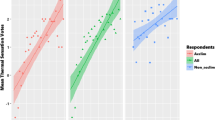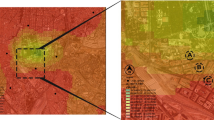Abstract
Thermal comfort is an important determinant of quality of life and economic vitality in cities. Strategies to improve thermal comfort may become a more critical part of urban sustainability efforts with projections of continued urban growth and climate change. A case study was performed in the hot, dry summertime climate of Tempe, Arizona to quantify the influence of evaporative misters on the thermal environment in outdoor restaurants and to understand business managers’ motivations to use misters. Microclimate measurements (air temperature (Ta), wind speed, relative humidity, globe temperature) were taken at five restaurants midday within four exposures: misted sun, misted shade, sun only, and shade only. We assessed Ta, mean radiant temperature (MRT), universal thermal climate index (UTCI), and physiological equivalent temperature (PET) between these four conditions within each location. Misters improved thermal comfort across all days, sites, and exposure conditions. MRT was on average 7.6 °C lower in misted locations, which significantly lowered average PET (– 6.5 °C) and UTCI (– 4.4 °C) (p < 0.05). Thermal comfort was most improved using mist in combination with shade. Under such conditions, PET and UTCI were reduced by 15.5 °C and 9.7 °C (p < 0.05), respectively. Business managers identified customer comfort and increased seating capacity as the principal factors for mister use. Esthetics of misters further encouraged use, while cost and environmental concerns were perceived to be less important. While this case study demonstrates value in outdoor misting in a hot, dry climate, additional work is needed to more fully evaluate tradeoffs between cost, water use, and comfort with continuing urban growth.



Similar content being viewed by others
Data availability
Raw data is available on the ERAMS platform through Colorado State University (https://erams.com/UWIN/data/microclimate-impacts-of-evaporative-misters/) .
References
Anderson SD, Bradford BJ, Harner JP, Tucker CB, Choi CY, Allen JD, Hall LW, Rungruang S, Collier RJ, Smith JF (2013) Effects of adjustable and stationary fans with misters on core body temperature and lying behavior of lactating dairy cows in a semiarid climate. J Dairy Sci 96:4738–4750
ASHRAE (1966) Thermal Comfort Conditions. ASHRAE Standards 55-66, New York
Bottcher RW, Baughman GR, Kesler DJ (1989) Evaporative cooling using a pneumatic misting system. Trans ASAE 32:671–683
Bröde P, Fiala D, Błażejczyk K, Holmér I, Jendritzky G, Kampmann B, Tinz B, Havenith G (2012) Deriving the operational procedure for the Universal Thermal Climate Index (UTCI). Int J Biometeorol 56:481–494
Brown RD, Vanos JK, Kenny NA, Lenzholzer S (2015) Designing urban parks that ameliorate the effects of climate change. Landc Urban Plan. 138:118–131. https://doi.org/10.1016/j.landurbplan.2015.02.006
Chow WTL, Brennan D, Brazel AJ (2012) Urban heat island research in Phoenix, Arizona: theoretical contributions and policy applications. Bull Am Meteorol Soc 93:517–530
Dhariwal J, Manandhar P, Bande L, Marpu P, Armstrong P, Reinhart CF (2019) Evaluating the effectiveness of outdoor evaporative cooling in a hot, arid climate. Build Environ 150:281–288
European CDC (2015) Legionnaires’ disease in Europe
Fanger PO (1972) Thermal Comfort. McGraw-Hill Book Company, New York
Farnham C, Emura K, Mizuno T (2015) Evaluation of cooling effects: outdoor water mist fan. Build Res Inf 43:334–345
Fitzhenry R, Weiss D, Cimini D et al (2017) Legionnaires’ disease outbreaks and cooling towers, New York City, New York, USA. Emerg Infect Dis 23:1769
Garrison L, Kunz J, Cooley L et al (2016) Vital signs: deficiencies in environmental control identified in outbreaks of legionnaires’ disease — North America, 2000–2014. MMWR Morb Mortal Wkly Rep 65:576–584
Gehrels H, van der Meulen S, Schasfoort F et al (2016) Designing green and blue infrastructure to support healthy urban living. TO2 Federatie, Utrecht
Georgescu M, Moustaoui M, Mahalov A, Dudhia J (2013) Summer-time climate impacts of projected megapolitan expansion in Arizona. Nat Clim Chang 3:37–41
Graham DA, Vanos JK, Kenny NA, Brown RD (2016) The relationship between neighbourhood tree canopy cover and heat-related ambulance calls during extreme heat events in Toronto, Canada. Urban For Urban Green 20. https://doi.org/10.1016/j.ufug.2016.08.005
Harlan SL, Ruddell DM (2011) Climate change and health in cities: impacts of heat and air pollution and potential co-benefits from mitigation and adaptation. Curr Opin Environ Sustain 3:126–134
Höppe P (1999) The physiological equivalent temperature–a universal index for the biometeorological assessment of the thermal environment. Int J Biometeorol 43:71–75
ISO 7726 (1998) Ergonomics of the thermal environment -- Instruments for measuring physical quantities. Genva
Jenerette GD, Harlan SL, Stefanov WL, Martin CA (2011) Ecosystem services and urban heat riskscape moderation: water, green spaces, and social inequality in Phoenix, USA. Ecol Appl 21:2637–2651
Jones TF, Rowland JR, Crosier SC et al (2003) Epidemiologic investigation of a restaurant-associated outbreak of pontiac fever. Clin Infect Dis 37:1292–1297. https://doi.org/10.1086/379017
Kántor N, Égerházi L, Unger J (2012a) Subjective estimation of thermal environment in recreational urban spaces—part 1: investigations in Szeged, Hungary. Int J Biometeorol 56:1075–1088
Kántor N, Unger J, Gulyás Á (2012b) Subjective estimations of thermal environment in recreational urban spaces—Part 2: international comparison. Int J Biometeorol 56:1089–1101
Kestrel (2016) Kestrel - Tips for Taking Accurate Measurements
Klemm W, Heusinkveld BG, Lenzholzer S, Jacobs MH, van Hove B (2015) Psychological and physical impact of urban green spaces on outdoor thermal comfort during summertime in The Netherlands. Build Environ 83:120–128
Lafortezza R, Carrus G, Sanesi G, Davies C (2009) Benefits and well-being perceived by people visiting green spaces in periods of heat stress. Urban For Urban Green 8:97–108
Lees AM, Sejian V, Wallage AL, Steel CC, Mader TL, Lees JC, Gaughan JB (2019) The impact of heat load on cattle. Animals 9:322
Makaremi N, Salleh E, Jaafar MZ, GhaffarianHoseini A (2012) Thermal comfort conditions of shaded outdoor spaces in hot and humid climate of Malaysia. Build Environ 48:7–14
Matzarakis A, Endler C (2010) Climate change and thermal bioclimate in cities: impacts and options for adaptation in Freiburg, Germany. Int J Biometeorol
Matzarakis A, Rutz F, Mayer H (2007) Modelling radiation fluxes in simple and complex environments, application of the {R}ay{M}an model. Int J Biometeorol 51:323–334
Matzarakis A, Rutz F, Mayer H (2010) Modelling radiation fluxes in simple and complex environments: basics of the RayMan model. Int J Biometeorol 54:131–139
McCarthy MP, Best MJ, Betts RA (2010) Climate change in cities due to global warming and urban effects. Geophys Res Lett 37:1–5
Middel A, Brazel AJ, Kaplan S, Myint SW (2012) Daytime cooling efficiency and diurnal energy balance in Phoenix, Arizona, USA. Clim Res 54:21–34
Middel A, Häb K, Brazel AJ, Martin CA, Guhathakurta S (2014) Impact of urban form and design on mid-afternoon microclimate in Phoenix Local Climate Zones. Landsc Urban Plan 122:16–28
Middel A, Selover N, Hagen B, Chhetri N (2016) Impact of shade on outdoor thermal comfort—a seasonal field study in Tempe, Arizona. Int J Biometeorol 60:1849–1861. https://doi.org/10.1007/s00484-016-1172-5
Middel A, Lukasczyk J, Maciejewski R (2017) Sky view factors from synthetic fisheye photos for thermal comfort routing--a case study in phoenix, Arizona. Urban Plan 2:19–31
Nikolopoulou M (2011) Outdoor thermal comfort. Front Biosci 3:1552–1568
Ortiz XA, Smith JF, Villar F, Hall L, Allen J, Oddy A, al-Haddad A, Lyle P, Collier RJ (2015) A comparison of 2 evaporative cooling systems on a commercial dairy farm in Saudi Arabia. J Dairy Sci 98:8710–8722. https://doi.org/10.3168/jds.2015-9616
Parr A, Whitney EA, Berkelman RL (2015) Legionellosis on the rise: a review of guidelines for prevention in the United States. J Public Health Manag Pract 21:E17–E26. https://doi.org/10.1097/PHH.0000000000000123
Pearlmutter D, Erell E, Etzion Y, Meir IA, di H (1996) Refining the use of evaporation in an experimental down-draft cool tower. Energy Build 23:191–197
Pearlmutter D, Berliner P, Shaviv E (2007) Integrated modeling of pedestrian energy exchange and thermal comfort in urban street canyons. Build Environ 42:2396–2409
Pohlert T (2014) The Pairwise multiple comparison of mean ranks package (PMCMR). R package
Rodriguez EA, Alvarez S, Martin R (1991) Direct air cooling from water drop evaporation. In: Architecture and Urban Space. Proceedings of the Ninth International PLEA Conference, Seville, pp 619–624
RStudio Team (2019) RStudio: Integrated Devlopment Environment for R
Ryan DP, Boland MP, Kopel E, Armstrong D, Munyakazi L, Godke RA, Ingraham RH (1992) Evaluating two different evaporative cooling management systems for dairy cows in a hot, dry climate. J Dairy Sci 75:1052–1059. https://doi.org/10.3168/jds.S0022-0302(92)77849-7
Santamouris M, Kolokotsa D (2015) On the impact of urban overheating and extreme climatic conditions on housing, energy, comfort and environmental quality of vulnerable population in Europe. Energy Build 98:125–133
Saraz O, Alexander J, Ferreira Tinôco I de F et al (2011) Modeling and experimental validation to estimate the energy balance for a poultry house with misting cooling. Dyna 78:167–174
Scott D, Lemieux C (2010) Weather and climate information for tourism. Procedia Environ Sci 1:146–183
Thorsson S, Lindberg F, Eliasson I, Holmer B (2007) Different methods for estimating the mean radiant temperature in an outdoor urban setting. Int J Clim 27:1983–1993
Uchiyama S, Suzuki K, Tsujimoto S, Koizumi H (2008) An experiment in reducing temperatures at a rail platform. Jpn Soc Plumb Eng 25:2
Ulpiani G (2019) Water mist spray for outdoor cooling: a systematic review of technologies, methods and impacts. Appl Energy 254:113647
Vanos JK, Herdt AJ, Lochbaum MR (2017) Effects of physical activity and shade on the heat balance and thermal perceptions of children in a playground microclimate. Build Environ 126:119–131. https://doi.org/10.1016/j.buildenv.2017.09.026
Wong NH, Chong AZM (2010) Performance evaluation of misting fans in hot and humid climate. Build Environ 45:2666–2678
Yamada H, Okumiya M, Tsujimoto M, Harada M (2006) Study on cooling effect with water mist sprayer: Measurement on global loop at the 2005 world exposition. In: Architectural Inst. of Japan Congress. p 677
Zheng K, Yuan C, Wong NH, Cen C (2019) Dry mist systems and its impact on thermal comfort for the tropics. Sustain Cities Soc 51:101727
Acknowledgments
This work was conducted as part of the Urban Water Innovation Network, supported by NSF Cooperative Agreement 1444758. The authors appreciate administrative support and guidance from Alan Berkowitz, Aude Lochet, Matei Georgescu, Mazdak Arabi, and Sarah Millonig, as well as the time, generosity, and access shared with us by managers of the establishments where data were collected in Tempe, Arizona. We would also like to thank Haven Guyer for her help and two anonymous reviewers for their very helpful comments in strengthening the current paper.
Funding
This work was funded by NSF Sustainability Research Network (SRN) Cooperative Agreement 1444758 as part of the Urban Water Innovation Network.
Author information
Authors and Affiliations
Contributions
Conceptualization: DH, AM, AK, MW, and JV. Methodology: DH, AM, AK, and AW. Analysis: JV, DH, AM, MW, AK, and HA. Investigation: AK and MW. Writing—original draft: JV, DH, MW, AK, and HA. Writing—review and editing: JV, DH, AM, MW, HA, and AK.
Corresponding author
Ethics declarations
Conflict of interest
The authors declare that they have no conflict of interest.
Additional information
Publisher’s note
Springer Nature remains neutral with regard to jurisdictional claims in published maps and institutional affiliations.
Supplementary Information
ESM 1
(DOCX 13 kb)
Rights and permissions
About this article
Cite this article
Vanos, J.K., Wright, M.K., Kaiser, A. et al. Evaporative misters for urban cooling and comfort: effectiveness and motivations for use. Int J Biometeorol 66, 357–369 (2022). https://doi.org/10.1007/s00484-020-02056-y
Received:
Revised:
Accepted:
Published:
Issue Date:
DOI: https://doi.org/10.1007/s00484-020-02056-y




